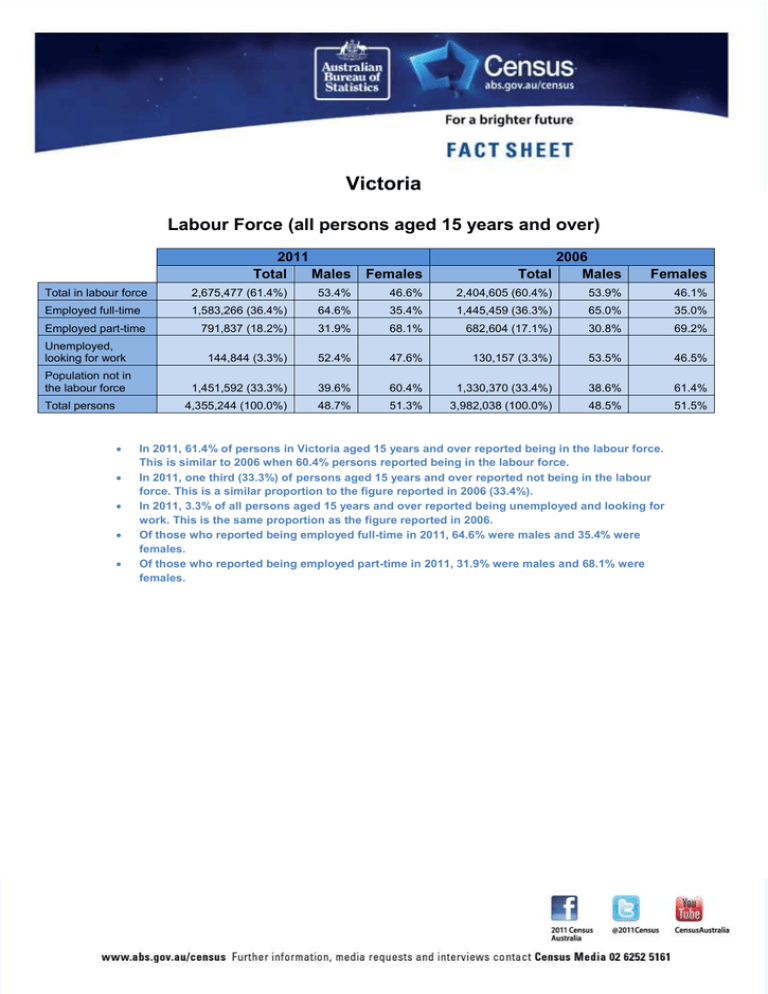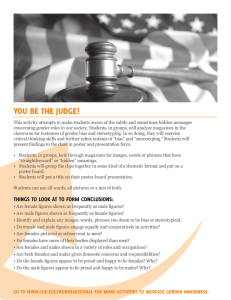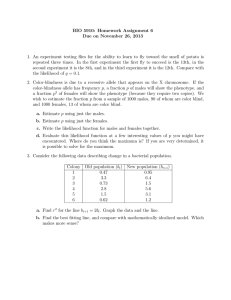Victoria Labour Force (all persons aged 15 years and over) A
advertisement

A Victoria Labour Force (all persons aged 15 years and over) 2011 Total Males Females Total 2006 Males Females Total in labour force 2,675,477 (61.4%) 53.4% 46.6% 2,404,605 (60.4%) 53.9% 46.1% Employed full-time 1,583,266 (36.4%) 64.6% 35.4% 1,445,459 (36.3%) 65.0% 35.0% 791,837 (18.2%) 31.9% 68.1% 682,604 (17.1%) 30.8% 69.2% 144,844 (3.3%) 52.4% 47.6% 130,157 (3.3%) 53.5% 46.5% 1,451,592 (33.3%) 39.6% 60.4% 1,330,370 (33.4%) 38.6% 61.4% 4,355,244 (100.0%) 48.7% 51.3% 3,982,038 (100.0%) 48.5% 51.5% Employed part-time Unemployed, looking for work Population not in the labour force Total persons In 2011, 61.4% of persons in Victoria aged 15 years and over reported being in the labour force. This is similar to 2006 when 60.4% persons reported being in the labour force. In 2011, one third (33.3%) of persons aged 15 years and over reported not being in the labour force. This is a similar proportion to the figure reported in 2006 (33.4%). In 2011, 3.3% of all persons aged 15 years and over reported being unemployed and looking for work. This is the same proportion as the figure reported in 2006. Of those who reported being employed full-time in 2011, 64.6% were males and 35.4% were females. Of those who reported being employed part-time in 2011, 31.9% were males and 68.1% were females. A Victoria Weekly Hours Worked (employed persons aged 15 years and over) 40 hours and above Total Males 2011 Females Total Males 2006 Females 1,137,349 (44.9%) 68.8% 31.2% 1,076,537 (47.3%) 68.9% 31.1% 35-39 hours 445,918 (17.6%) 53.8% 46.2% 368,920 (16.2%) 53.7% 46.3% 25-34 hours 256,632 (10.1%) 33.1% 66.9% 214,869 (9.4%) 32.4% 67.6% 16-24 hours 245,457 (9.7%) 29.7% 70.3% 204,851 (9.0%) 28.1% 71.9% 388,539 (15.4%) 35.2% 64.8% 345,381 (15.2%) 35.0% 65.0% 2,530,635 (100.0%) 53.4% 46.6% 2,274,447 (100.0%) 53.9% 46.1% 0-15 hours Total persons Of all employed persons aged 15 years and over, 44.9% reported working 40 hours or more in the week prior to the 2011 Census. A higher proportion of these were males (68.8%). Between the 2006 and 2011 Census there was a 2.4 percentage point decline in the proportion of persons who reported working 40 hours or more (47.3% in 2006 compared to 44.9% in 2011). Of all employed persons aged 15 years and over, 15.4% reported working 0 to 15 hours in the week prior to the 2011 Census. A higher proportion of these were females (64.8%). A Victoria Top five Industries in 2011 (employed persons aged 15 years and over) Health Care and Social Assistance Retail Trade Manufacturing Construction Education and Training Total persons Total 2011 Males Females Total 2006 Males Females 292,418 (11.6%) 273,716 (10.8%) 271,052 (10.7%) 210,973 (8.3%) 202,319 (8.0%) 2,530,635 (100.0%) 20.5% 42.9% 72.7% 87.9% 30.7% 53.4% 79.5% 57.1% 27.3% 12.1% 69.3% 46.6% 236,551 (10.4%) 263,449 (11.6%) 287,106 (12.6%) 171,464 (7.5%) 174,424 (7.7%) 2,274,447 (100.0%) 20.5% 43.3% 72.5% 87.4% 31.2% 53.9% 79.5% 56.7% 27.5% 12.6% 68.8% 46.1% In 2011, of all employed persons aged 15 years and over, the largest proportion reported working in the Health Care and Social Assistance industry (11.6%). In 2006, the Manufacturing industry was the most reported response for employed persons aged 15 years and over (12.6%). The proportion of all employed persons aged 15 years and over who reported being employed in this industry declined to 10.7% in 2011, and there has been a decrease in the number of persons employed in this industry (16,054 persons). In 2011, of persons who reported working in the Manufacturing industry, 72.7% were males. In 2011, of persons employed in the industries of Health Care and Social Assistance, Education and Training and Retail Trade, a higher proportion were females (79.5%, 69.3% and 57.1% respectively). A Victoria Top five Occupations in 2011 (employed persons aged 15 years and over) 2011 Total Males Professionals Clerical and Administrative Workers Technicians and Trades Workers Managers Sales Workers Total persons Females Total 2006 Males Females 564,778 (22.3%) 46.2% 53.8% 472,303 (20.8%) 47.1% 52.9% 364,499 (14.4%) 25.1% 74.9% 337,418 (14.8%) 24.4% 75.6% 350,758 (13.9%) 332,929 (13.2%) 245,333 (9.7%) 2,530,635 (100.0%) 84.8% 65.6% 38.9% 53.4% 15.2% 34.4% 61.1% 46.6% 319,190 (14.0%) 306,321 (13.5%) 230,376 (10.1%) 2,274,447 (100.0%) 85.0% 66.7% 38.7% 53.9% 15.0% 33.3% 61.3% 46.1% In 2011, 22.3% of all employed persons aged 15 years and over reported working as Professionals. Of these, 53.8% were females. The proportion of those who reported working as Professionals has increased by 1.5 percentage points from 20.8% in 2006 to 22.3% in 2011. In 2011, of all persons who reported working as Technicians and Trades Workers (13.9%), a higher proportion were males (84.8%). In 2011, of all persons who reported working as Clerical and Administrative Workers (14.4%) and Sales Workers (9.7%), a higher proportion were females (74.9% and 61.1% respectively). A Victoria Highest Level of Education (all persons aged 15 years and over) 2011 Total Males Postgraduate Degree Females Total 2006 Males Females 170,380 (3.9%) 53.0% 47.0% 108,122 (2.7%) 57.3% 42.7% 95,353 (2.2%) 35.8% 64.2% 74,048 (1.9%) 36.3% 63.7% 641,216 (14.7%) 44.5% 55.5% 502,514 (12.6%) 44.9% 55.1% 364,758 (8.4%) 43.8% 56.2% 289,645 (7.3%) 43.4% 56.6% Certificate III/IV 611,193 (14.0%) 70.1% 29.9% 516,488 (13.0%) 74.1% 25.9% Year 12 730,258 (16.8%) 46.6% 53.4% 650,896 (16.3%) 46.1% 53.95 1,208,773 (27.8%) 44.0% 56.0% 1,254,285 (31.5%) 43.1% 56.9% 4,355,244 (100.0%) 48.7% 51.3% 3,982,038 (100.0%) 48.5% 51.5% Graduate Diploma & Certificate Bachelor Degree Advanced Diploma and Diploma Year 11 or below (includes Certificate I/II/nfd) Total persons nfd: Not further defined In 2011, there was a significant increase in the number of persons who reported completing a Postgraduate Degree, from 108,122 in 2006 to 170,380 in 2011 (an increase of 57.6%). There has been significant increase in the number of persons who reported completing a Graduate Diploma or Graduate Certificate as their highest level of education. This increased from 74,048 in 2006 to 95,353 in 2011 (an increase of 28.8%). There was a significant increase of 27.6% in the number of persons who reported completing a Bachelor Degree as their highest level of education, from 502,514 in 2006 to 641,216 in 2011. There has been a decline in the number of persons who reported Year 11 and below, including Certificate level I/II,) as their highest level of education, from 1,254,285 in 2006 to 1,208,773 in 2011. In 2011, a higher proportion of females than males reported their highest level of education as Graduate Diploma or Graduate Certificate, Bachelor Degree, and Advance Diploma or Diploma (64.2%, 55.5% and 56.2% respectively). Of all persons who reported completing Certificate III/IV as their highest level of education a higher proportion were males (70.1%). A Victoria Top five Fields of Study in 2011 (all persons aged 15 years and over who stated a completed qualification) Management and Commerce Engineering and Related Technologies Society and Culture Health Education Total persons Total 2011 Males Females Total 2006 Males Females 434,724 (17.8%) 43.3% 56.7% 330,061 (15.8%) 43.2% 56.8% 354,935 (14.5%) 259,366 (10.6%) 222,101 (9.1%) 182,544 (7.5%) 2,443,534 (100.0%) 92.2% 31.2% 21.6% 25.7% 51.1% 7.8% 68.8% 78.4% 74.3% 48.9% 322,173 (15.4%) 191,841 (9.2%) 178,893 (8.5%) 159,802 (7.6%) 2,092,406 (100.0%) 92.5% 33.2% 21.2% 26.5% 52.1% 7.5% 66.8% 78.8% 73.5% 47.9% In 2011 Management and Commerce (17.8%) and Engineering and Related Technologies (14.5%) were the two most common fields of study that were reported by all persons aged 15 years and over who stated a completed qualification. These fields were also reported as the most common fields of study in the 2006 Census. Between the 2006 Census and 2011 Census there has been a decline in the proportion of those who reported Engineering and Related Technologies (0.9 percentage points). In addition there has been an increase in the proportion of persons who reported Management and Commerce (2.0 percentage points). Of all persons who reported Management and Commerce and Society and Culture as their field of study a higher proportion were females (56.7% and 68.8% respectively). Of all persons who reported Engineering and Related Technologies as their field of study, the proportion of males was significantly higher (92.2%). Almost three quarters of those who reported Health and Education as fields of study were females (78.4% and 74.3% respectively). A Victoria Top five Methods of Travel to Work in 2011 (employed persons aged 15 years and over) Car, as driver Train Car, as passenger Walked only Tram Total persons 2011 Total Persons 2006 Total Persons 1,554,489 (61.4%) 120,233 (4.8%) 116,099 (4.6%) 83,525 (3.3%) 42,696 (1.7%) 2,530,635 (100.0%) 1,394,018 (61.3%) 90,067 (4.0%) 111,031 (4.9%) 80,539 (3.5%) 33,340 (1.5%) 2,274,447 (100.0%) Transport by car continues to be the most commonly reported method of travel to work. Almost two thirds (66.0%) of all employed persons aged 15 years and over reported that they travelled to work by car (either as driver or a passenger) on 9 August 2011. The number of those who travelled to work by train has grown from 90,067 (4.0%) in 2006 to 120,233 (4.8%) in 2011. Similarly, the number of those who travelled to work by tram increased from 33,340 (1.5%) in 2006 to 42,696 (1.7%) in 2011. The number of those who walked to work has grown slightly from 80,539 in 2006 to 83,525 in 2011, however the proportion of persons who walked to work has declined from 3.5% in 2006 to 3.3% in 2011 (reflecting a slower rate of growth compared to other forms of travel). A Victoria Place of Usual Residence one year ago (all persons who moved, excluding persons aged under one year) 2011 2006 595,782 (80.6%) 549,135 (81.3%) Interstate 58,010 (7.8%) 51,792 (7.7%) Overseas 78,562 (10.6%) 68,991 (10.2%) 739,460 (100.0%) 675,698 (100.0%) Within State Total persons Of the Victorian residents who moved in the year prior to the 2011 Census, most moved within the State (80.6%). There were 78,562 (10.6%) of persons who had moved to Victoria from overseas in the year prior to the 2011 Census. Place of Usual Residence five years ago (all persons who moved, excluding persons aged under five years) 2011 2006 1,373,493 (74.1%) 1,333,618 (79.0%) Interstate 147,749 (8.0%) 135,948 (8.0%) Overseas 312,606 (16.9%) 209,417 (12.0%) 1,853,246 (100.0%) 1,695,771 (100.0%) Within State Total persons Almost three quarters (74.1%) of the Victorian residents who moved in the five years prior to the 2011 Census moved within the State. There were 312,606 (16.9%) of persons who had moved to Victoria from overseas in the five years prior to the 2011 Census.





